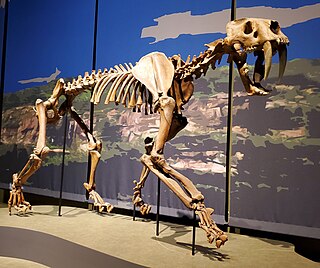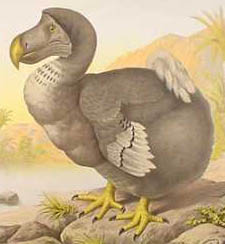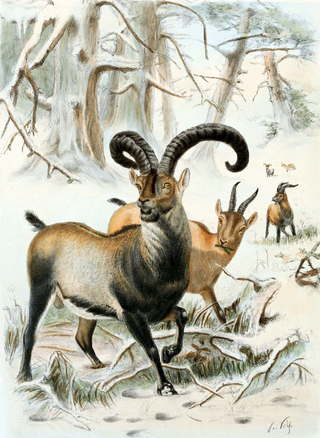
The thylacine, also commonly known as the Tasmanian tiger or Tasmanian wolf, is an extinct carnivorous marsupial that was native to the Australian mainland and the islands of Tasmania and New Guinea. The thylacine had died out on New Guinea and mainland Australia around 3,500 years ago, prior to the arrival of Europeans, possibly because of the introduction of the dingo, whose earliest record dates to around the same time, but which never reached Tasmania. Prior to European settlement around 5,000 remained in the wild on Tasmania. Beginning in the nineteenth century they were perceived as a threat to the livestock of farmers and bounty hunting was introduced. The last known of its species died in 1936 at Hobart Zoo in Tasmania. The thylacine is widespread in popular culture and is a cultural icon in Australia.

The lion is a large cat of the genus Panthera native to Africa and India. It has a muscular, broad-chested body; short, rounded head; round ears; and a hairy tuft at the end of its tail. It is sexually dimorphic; adult male lions are larger than females and have a prominent mane. It is a social species, forming groups called prides. A lion's pride consists of a few adult males, related females, and cubs. Groups of female lions usually hunt together, preying mostly on large ungulates. The lion is an apex and keystone predator; although some lions scavenge when opportunities occur and have been known to hunt humans, lions typically do not actively seek out and prey on humans.

Extinction is the termination of a taxon by the death of its last member. A taxon may become functionally extinct before the death of its last member if it loses the capacity to reproduce and recover. Because a species' potential range may be very large, determining this moment is difficult, and is usually done retrospectively. This difficulty leads to phenomena such as Lazarus taxa, where a species presumed extinct abruptly "reappears" after a period of apparent absence.

Smilodon is a genus of the extinct machairodont subfamily of the felids. It is one of the best known saber-toothed predators and one of the most famous prehistoric mammals. Although commonly known as the saber-toothed tiger, it was not closely related to the tiger or other modern cats. Smilodon lived in the Americas during the Pleistocene epoch. The genus was named in 1842 based on fossils from Brazil; the generic name means "scalpel" or "two-edged knife" combined with "tooth". Three species are recognized today: S. gracilis, S. fatalis, and S. populator. The two latter species were probably descended from S. gracilis, which itself probably evolved from Megantereon. The hundreds of specimens obtained from the La Brea Tar Pits in Los Angeles constitute the largest collection of Smilodon fossils.

Homotherium is an extinct genus of machairodontine scimitar-toothed cat that inhabited North America, South America, Eurasia, and Africa during the Pliocene and Pleistocene epochs from around 4 million to 12,000 years ago. In comparison to Smilodon, the canines of Homotherium were shorter, and it was probably adapted to running down rather than ambushing prey.

A saber-tooth is any member of various extinct groups of predatory therapsids, predominantly carnivoran mammals, that are characterized by long, curved saber-shaped canine teeth which protruded from the mouth when closed. Saber-toothed mammals have been found almost worldwide from the Eocene epoch to the end of the Pleistocene epoch 42 million years ago (mya) – 11,000 years ago (kya).

Copenhagen Zoo is a zoological garden in Copenhagen, Denmark. Founded in 1859, it is one of the oldest zoos in Europe and is a member of EAZA. It comprises 11 hectares and is located in the municipality of Frederiksberg, sandwiched between the parks of Frederiksberg Gardens and Søndermarken. With 1,571,331 visitors in 2019 it is the most visited zoo and one of the most visited attractions in Denmark. The zoo is noted for its new Elephant House designed by British architect Sir Norman Foster. The zoo maintains and promotes a number of European breeding programmes.

Machairodontinae is an extinct subfamily of carnivoran mammals of the family Felidae. They were found in Asia, Africa, North America, South America, and Europe from the Miocene to the Pleistocene, living from about 16 million until about 11,000 years ago.

The Javan tiger was a Panthera tigris sondaica population native to the Indonesian island of Java until the mid-1970s. It was hunted to extinction, and its natural habitat converted for agricultural land use and infrastructure. It was one of the three tiger populations in the Sunda Islands.

Save China's Tigers (SCT) is an international charitable foundation based in Hong Kong, the United States, and the United Kingdom which aims to save the big cats of China from extinction. It focuses on the Chinese tigers. It also has branches in Mainland China and South Africa.

The Last Dodo is a BBC Books original novel written by Jacqueline Rayner and based on the long running science fiction television series Doctor Who. It features the Tenth Doctor and Martha Jones. It was published on 19 April 2007, after the television debut of companion Martha Jones, alongside Sting of the Zygons, and Wooden Heart.

Bird conservation is a field in the science of conservation biology related to threatened birds. Humans have had a profound effect on many bird species. Over one hundred species have gone extinct in historical times, although the most dramatic human-caused extinctions occurred in the Pacific Ocean as humans colonised the islands of Melanesia, Polynesia and Micronesia, during which an estimated 750–1,800 species of birds became extinct. According to Worldwatch Institute, many bird populations are currently declining worldwide, with 1,200 species facing extinction in the next century. The biggest cited reason surrounds habitat loss. Other threats include overhunting, accidental mortality due to structural collisions, long-line fishing bycatch, pollution, competition and predation by pet cats, oil spills and pesticide use and climate change. Governments, along with numerous conservation charities, work to protect birds in various ways, including legislation, preserving and restoring bird habitat, and establishing captive populations for reintroductions.

Pleistocene rewilding is the advocacy of the reintroduction of extant Pleistocene megafauna, or the close ecological equivalents of extinct megafauna. It is an extension of the conservation practice of rewilding, which involves reintroducing species to areas where they became extinct in recent history.

Out of the approximately 11,154 known bird species, 159 (1.4%) have become extinct, 226 (2%) are critically endangered, 461 (4.1%) are endangered, 800 (7.2%) are vulnerable and 1,018 (9.1%) are near threatened. There is a general consensus among scientists who study these trends that if human impact on the environment continues as it has, one-third of all bird species and an even greater proportion of bird populations will be gone by the end of this century.

Tiger attacks are a form of human–wildlife conflict which have killed more humans than attacks by any of the other big cats. The most comprehensive study of deaths due to tiger attacks estimates that at least 373,000 people died due to tiger attacks between 1800 and 2009 averaging about 1800 kills per year, the majority of these attacks occurring in Bangladesh, India, Nepal and Southeast Asia.
Monsters We Met is a documentary produced by the BBC that later aired as a special on Animal Planet in 2004 which also included footage from Walking with Beasts and Walking with Cavemen. The show used computer-generated imagery to recreate the life of the giant animals that lived during the last ice age and explains how early humans encountered them. It also features humans as the main reason for the extinction of all great animals.
Before We Ruled the Earth is a two-part documentary television miniseries that premiered on February 9, 2003 on the Discovery Channel. The program featured early human history and the challenges human beings faced thousands of years ago. The first episode was called "Hunt or Be Hunted" and the second called "Mastering the Beasts."

Fatal Attractions is a recurring documentary program that was broadcast on Animal Planet. First aired in 2010, the show focused on humans who have kept animals as unconventional pets that have turned out to be dangerous and sometimes fatal. The program's last new episode aired in February 2013.

De-extinction is the process of generating an organism that either resembles or is an extinct species. There are several ways to carry out the process of de-extinction. Cloning is the most widely proposed method, although genome editing and selective breeding have also been considered. Similar techniques have been applied to certain endangered species, in hopes to boost their genetic diversity. The only method of the three that would provide an animal with the same genetic identity is cloning. There are benefits and drawbacks to the process of de-extinction ranging from technological advancements to ethical issues.
Colossal Biosciences is a biotechnology and genetic engineering company working to genetically resurrect the woolly mammoth, the Tasmanian tiger, and the dodo. It has claimed to have the first woolly mammoth hybrid calves by 2028 and will reintroduce them to the Arctic tundra habitat to restore the mammoth steppe grasslands and combat climate change. Endangered Asian elephants reportedly would have mammoth traits. Likewise, it plans to launch a thylacine research project to release Tasmanian tiger joeys back to their original Tasmanian and broader Australian habitat after a period of observation in captivity.